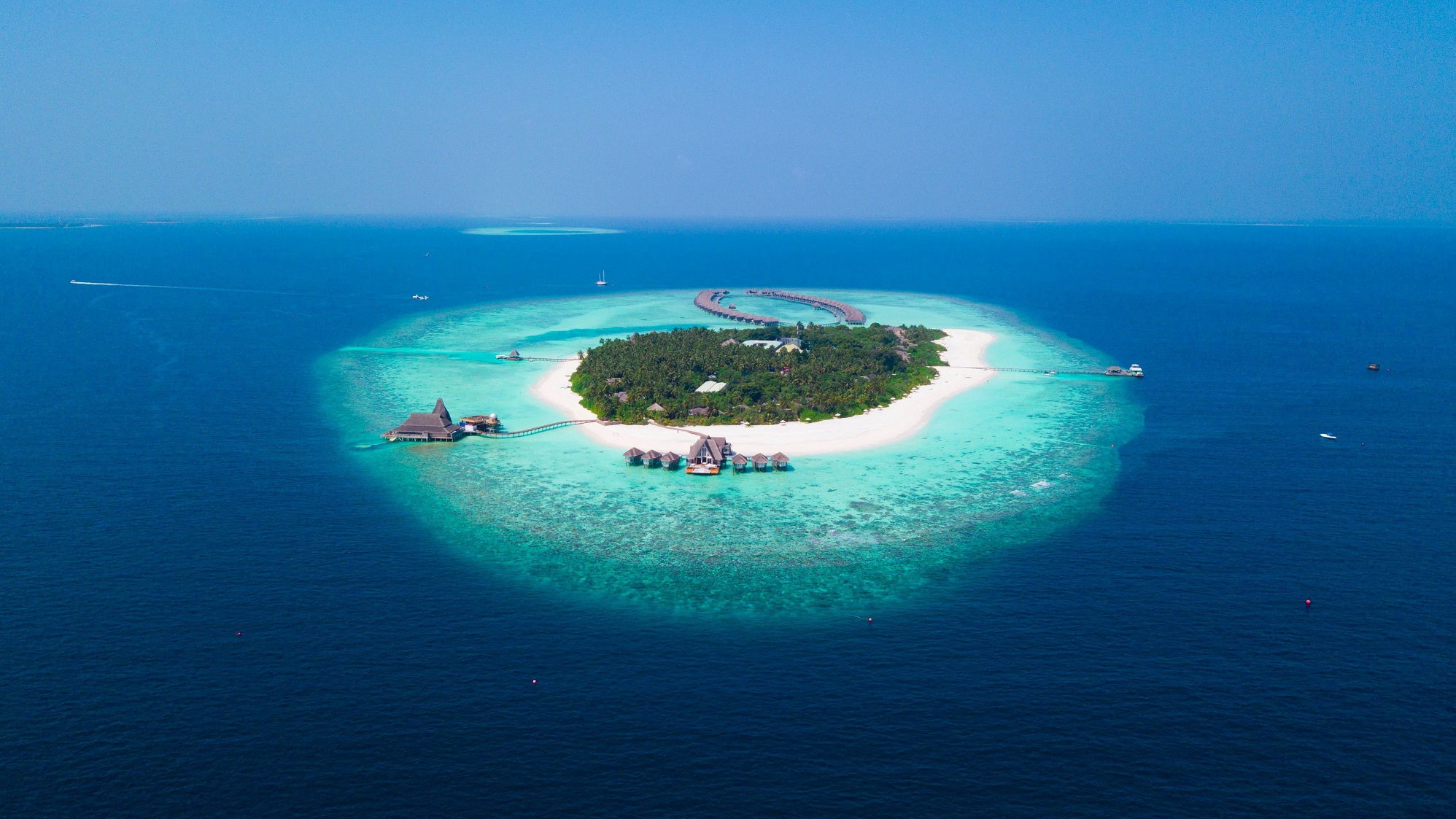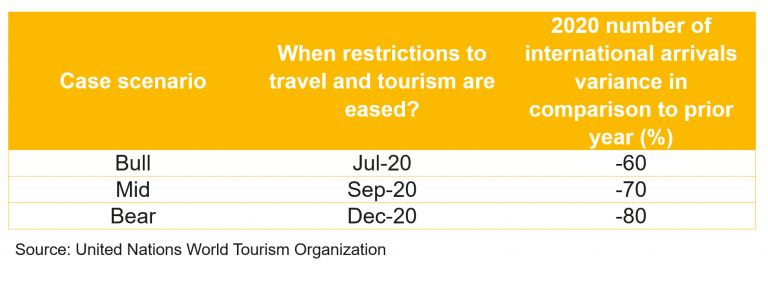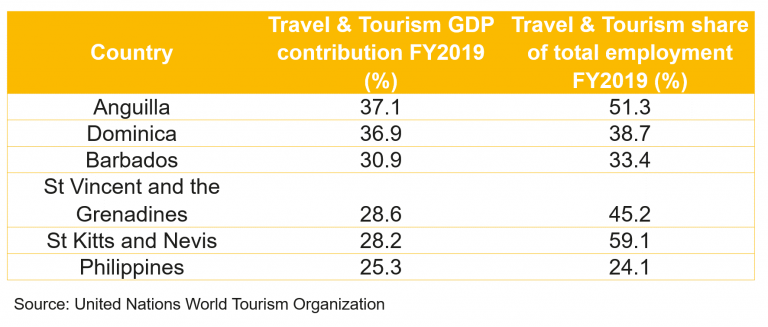COVID-19 free zones: A proposal for a new tourism product

When COVID-19 hit, the world went into lockdown ceasing the vast majority of international travel. The impact on the tourism industry is enormous. Countries that predominately rely on tourism as faced with major economic consequences. While it is unlikely the tourism industry will return to its pre-pandemic normal once travel restriction are lifted, we ask the question what the alternatives are. In this article we discuss the impact of the pandemic on employment rates and GDP growth from tourism, and explore an alternative tourism product to restart the industry.
Running the numbers
Forecasts from United Nations World Tourism Organization predict that, this year international travel will drop by 850 million to 1.1 billion or by 60% to 80% in comparison to 2019 as a result of the pandemic. The degree of decline varies depending on the duration of containment measures and is broken down into three possible scenarios. The table below summarises each scenario outcome and assumption.

The global economic impact of COVID-19 to travel and tourism industry will be five times greater than the impact of 2008 global financial crisis.
Travel and tourism contribution to GDP in 2019 amounted to US$8.9t or 10.3% of the global economy. In 2020, we expect a loss of US$2.7t or approximately 3.1% of travel and tourism GDP contribution to global economy1.Loss of US$0.9t to US$1.2t tourism export revenue. Total exports from international tourism amount to US$1.7t and comprise of US$1,448b international tourism receipts (visitor spending in destinations) and $256 billion in international passenger transport services. Tourism exports account for 7% of overall exports of goods and services and 29% of global service exports.
The impact on employment is substantial too. According to the World Travel & Tourism Council, an estimated 100 to 120 million direct tourism jobs are at risk: the equivalent of approximately 33% of industry jobs and 3.3% of global employment. In 2019, jobs within the tourism industry were estimated to account for 10% of global employment. Therefore, job losses in the tourism industry due to coronavirus are estimated to translate into a 2.9 percentage points global unemployment rate increase.
When we look at the consequences by country, economic impact varies. Economies with significant dependence on tourism are hit harder. Especially, where tourism receipts are generated from international arrivals. The table below shows the importance of tourism for a selected number of countries.

Scientific estimations about the virus confrontation vary. Some say a vaccine may not be available before summer 2021. But even then, experience shows that it will take time for tourism demand to return to normal. For example, the impact on tourism in Sierra Leone after the first case of Ebola was reported in 2013 was immediate. Tourist arrivals declined by 50% in 2014. To date, neither arrivals nor spending from international visitors have returned to their pre-epidemic level1.
Countries in which the economy strongly relies on tourism easily fall victim to severe poverty problems. The consequences of the pandemic to the tourism industry are unprecedented. Is there anything we can do to mitigate the impact?
A new product
To resume tourism, the industry needs to consider new business models and products that fit safety compliance rules, while remaining attractive to travellers and generating profit. One proposal is the development of ‘’virus-free zones’’. Destinations that can successfully offer a virus free environment can become new tourism hotspots. What would be the characteristics of such product?
Customer demand
Customer demand is different today than it was in pre-pandemic times. The holiday package is likely less focused to traditional tourist attractions such as sea, sun, cultural sites, sport activities, natural beauty and so on. Instead, packages play into the new demand for care-free socialising. The social distancing policies in place all around the world keep infection rates down, but also cause people to feel disconnected from one another. In some cases, the lack of social contact can cause severe mental health issues. Some groups of people are more vulnerable than others. Those in higher risk of serious illness if infected by COVID-19 are under stricter confinement and may have an ever greater desire to visit a destination where care-free social interaction with others is possible.
Year-round sales cycle
Pre-virus, there were several tourism products depending on destination type, such as city breaks, beach holidays, winter spots and summer destinations. These products were often subject to seasonal demand. Post-virus, we can distinguish virus free and virus risky destinations. Virus free destinations can be marketed all year round, effectively changes the sales cycle.
Premium pricing
A product like this will be more expensive to develop and maintain but can also be priced at a premium. Considering virus spread and containment difficulties, virus-free destinations will be limited. The cost of developing and maintaining virus-free destination such as an all-inclusive resort will also be greater than pre-pandemic times. As such, tourism businesses can price a premium for products like these. Keeping in mind that visitors are will spend their full stay within the virus-free zone, all spending will be concentrated within this one area. Travel in itself will be more difficult and possibly more expensive and time-consuming. This can result in longer stay once people have arrived to make the investment worth their while.
Virus-free zones
The development of virus-free zones won’t not an easy task, and strict safety and compliance protocols must be in place to ensure its sustainability. It requires close collaboration between government bodies such as urban planning and local centres for health and safety, and hospitality businesses ranging from transport operators and cleaning companies to hotel and restaurant businesses. Yet, as seen in the economic forecasts, the return on investment for local economies is worth it.
Before declaring a zone as virus free and deciding about its size, a careful evaluation of natural morphology, use of land, facilities, infrastructure and tourism contribution to local economies would be required. Urban planners would call this assessment zoning and labelling. Here are some of the virus free zone characteristics:
Isolation
Virus-free zones could be a broader geographic area of one country. For example, an island. Natural morphology is an important factor of isolation. Smaller zones such as an all-inclusive large resort after a period of self-isolation can be smaller scale zones as well.
Restriction
Physical interaction with people from other areas would be subject to restrictions, but totally free inside the virus free zone. Protocol for who is allowed into these areas needs to be in place.
Sustainability
Virus-free zones may expand only to the extent that tourism contributes to the economy without deteriorating anyone’s life. A virus free zone can only be small enough to secure safety from virus and large enough to include necessary facilities and infrastructures (i.e. schools, hospitals). The impact of those living and working within these zones must be taken into consideration, as they can’t leave the zone without the risk in contamination once they return.
Capacity
Destinations should evaluate their bearing capacity in relation to their healthcare systems.
The perfect traveller
Sooner or later the pandemic will be over. People will travel again. It is part of the very human nature to be curious and to explore. The Greek writer Kazantzakis wrote: “Every perfect traveller creates the country where he travels”. Before we start travelling again, it is worth to reconsider our travel expectations.
While tourism brings growth and prosperity to many economies, in some cases it also has negative consequences. There are numerous examples of intensive and irresponsible tourism development which have led to many landscape alteration, exhaustion of natural environment, and loss of cultural and folklore tradition. The pandemic poses an opportunity to rethink the tourism model and its long-term sustainability. It may also force countries with high dependence on tourism to reconsider their development model and diversify their economies.



